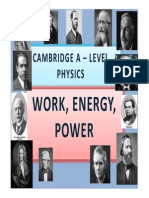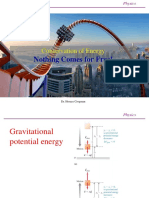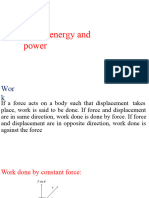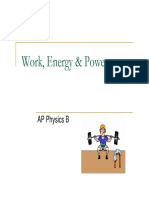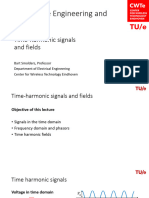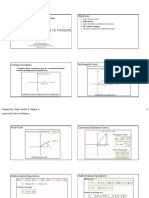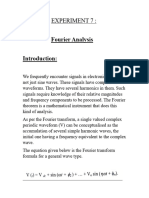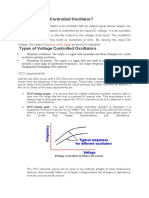AP Study Guide Part3
Uploaded by
yourbostonhomesAP Study Guide Part3
Uploaded by
yourbostonhomesfurther than the lowest height (zero potential energy), it can only loose this much potential energy.
We are really just
tracking changes in usable energy. This is why Work and Work-Energy Theorem is such a useful entity.
20 J of work were added to the system, doing positive work and raising the systems energy. Where did it come from? It
came from the environment. We will soon learn that energy is conserved and just either moves (transfers) between locations
(system and environment) or it changes form (potential to kinetic, etc.). If you drop the object it will loose 20 J of potential
energy. Since it is loosing energy, 20 J of negative work is done by gravity. Where does this energy go? It turns into 20 J of
kinetic energy. Then the object hits the table and stops. Now it has lost all of its height (potential energy) and all of its
velocity (kinetic energy). Where did the 20 J go? There was a sound, so molecules of air were pushed aside. The kinetic
energy of the molecules increased. The table vibrated. The kinetic energy of the molecules in the table increased. This
vibration is felt as heat. Where are the air molecules and table molecules? They are in the environment. So the 20 J returned
to the environment. What do you mean by returned to the environment? Well, when I picked up the mass in the first place I
was part of the environment, so the original 20 J used to lift the mass came from the environment in the very beginning.
Conservation of Energy: Energy cannot be created or destroyed, but it can change forms.
There are many forms of energy. Those that will be used in this course are shown in the energy wheel below (Note: AP
Physics C students will not cover Thermal or Modern). All the forms of energy are included here as this serves as a review
of the entire year. If any energy is unfamiliar to you at this point in the year don’t worry, we will cover them soon enough.
If energy can change form, then any energy can be equal to any other energy. If you drop an object the object looses height,
but gains velocity. In this case potential energy is turning into kinetic energy. If the object looses all of its height, then there
1
is a 100% transfer of energy to kinetic energy. mghi =
2
mv f . But, what if the energy is an incomplete transfer. What if
2
the problem ends before reaching zero height (zero potential energy). The object will then have two energies at the end.
1
mghi = mgh f + mv f . Energy is a scalar. It is directionless and simply adds without worrying about direction.
2
2
Basically, conservation of energy means that the total energy at the beginning of the problem must equal the total energy
at the end of the problem. What if the object has height and is moving at the beginning of the problem, and still has height
1 1
and is moving at the end of the problem? mghi + mvi = mgh f + mv f . The total energy in the problem is either
2 2
2 2
1 1
Etotal = mghi + mvi or Etotal = mgh f + mv f . The total energy is conserved, so the total energy is present at the
2 2
2 2
beginning, and it is still present at the end. What happens if the object is thrown straight upward, from the lowest point, and
1
mvi = mgh f . What if it is thrown upward at an
2
then reaches the highest point of flight where the velocity is zero?
2
1
angle so that when it reaches its highest point it still has some velocity in the x- direction? mghi = mgh f +
2
mv f . We
2
can see that conservation of energy is a very flexible and powerful tool.
Remember: Energy is directionless. Simply ask yourself:
1. What energy/energies are present initially and add them up on the left.
2. What energy/energies are present finally and add them up on the right.
Can energy be lost? No! Lost energy goes to the environment. A car (system) looses energy due to air resistance, so
air molecules (environment) gain energy and move faster. Energy is conserved in the universe.
Revised 8/29/06 21 © R H Jansen
Newtonian Mechanics The wheel to the left shows all the energies learned in this
class around the outside. They are grouped into the five
major strands of physics. In the center is work.
1 2
K= mv U g = mgh Conservation of Energy: Energy cannot be created
2 or destroyed it can change forms.
Gm1m2
1
U s = kx 2 Ug = Changing forms means that any energy/energies initial
2 r around the outside of the circle can change into any other
E = hf energy/energies final. ∑ Energyi = ∑ Energy f
Q = mc∆T
Modern Thermal In this class we often assume 100% energy transfer. One
Physics
W = F ∆r cos θ Physics energy may be present initially, which disappears, and
another energy is present at the end of the problem. In
hc Q = nc∆T
E= these 100% energy transfer problems any energy around
λ the wheel can equal any other energy. If more than two
energies are mentioned then you simply add up all
energies present initially and set them equal to the total of
U E = qV 1 all the final energies.
U c = CV 2
1 2 Work Energy Theorem: Work is a change in any
U c = QV
2 energy. W = Any Energy f − Any Energyi
Electricity & Magnetism Most of the time one of the energies, either final or initial
is equal to zero. So then Work can equal any energy
around the outside. And since W = Fr, then Fr can equal
any energy around the outside.
When do we use Conservation of Energy as Opposed to Work Energy Theorem? Conservation of
energy is used when energy stays in the system and simply changes form. Work Energy Theorem is used when energy
moves from the environment to the system and vice versa. You will see me use a hybrid of the two, in the examples below,
when energy is lost to the environment due to friction.
The following is an incomplete list of examples. Many of these are common problems, and have been represented in AP
Exams. In addition many are based on 100% efficiency of energy transfer. This is not really the case (see thermodynamics,
soon), but it makes the problems easier in the same way that an airless and frictionless world helped us to start kinematics.
Example 6-3: Height Turning Into Velocity
The path does not matter, only the change in height.
1
mghi =
2
For a 100% transfer: mv f h
2
Fig 6.3
Example 6-4: Roller Coaster vi
A roller coaster is a good example of incomplete transfer
of energy. At different points along the track there are
various amounts of both kinetic and potential energy. vf
One key to all these height problems, measured from a
planetary surface, is to declare the lowest point in a hi hf
problem to be h = 0. This gives a reference that is easy
to add or subtract from. Then if you are given the height
at any point on the track you can find the carts velocity: h=0
1 1
mghi + mvi = mgh f + mv f Fig 6.4
2 2
2 2
Revised 8/29/06 22 © R H Jansen
Example 6-5: Friction Stops an Object Ffr
Fig 6.3a shows an object that had height and stopped due to friction. Friction i r
is a force and the only way to use a force in an energy equation is to multiply
the force by the displacement, in other words use work. In this case it is the
work of friction. h
f
mghi = W fr mghi = Ffr r h=0
Fig 6.5a
If the object in Fig 6.3a did not stop, but was just slowed by friction then it
would still have some kinetic energy.
1 1
mghi = W fr + mv f mghi = Ffr r + mv f
2 2
2 2
Ffr
In figure 6.3b the object is sliding along a horizontal surface. It initially has i f
kinetic energy and is stopped by friction.
1 1 r
mvi = W fr mvi = Ffr r
2 2
Fig 6.5b
2 2
If the object in Fig 6.3b did not stop, but was just slowed by friction then it would still have some kinetic energy.
1 1 1 1
mvi = W fr + mv f mvi = Ffr r + mv f
2 2 2 2
2 2 2 2
Revised 8/29/06 23 © R H Jansen
Power: Power is the rate of work, or rate of energy change. In other words it is the rate that energy is used, transferred, or
generated during a one second interval. Since it involves energy, power is by extension as important.
W F ∆r
P= you can substitute for work P= , and if you note that displacement over time is velocity then,
t t
P = Fv . The first boxed equation is useful when you have work or energy, the second is useful when you have force.
Even though the first equation contains the expression for work, you must be flexible. You must realize that work is a
change in any energy P =
∆Any Energy . You can plug in any energy from the preceding page.
t
mgh 1 2mv 2
P= , P= , etc. If a problem contains any form of energy or work or the units of
t t
joules, and any quantity of time or any units of time, then it will involve power.
If energy is flexible then so is power. Occasionally a question gives power as a variable, but you need energy to
W
solve the problem. Simply set the time equal to one second, then P = and work/energy will have the same numerical
1s
value (but different units) as power for that one second. Use this value for Work/Energy to solve the problem. Just
remember that all answers obtained in the problem are based on one second. If time is given later on, just multiple the energy
of “one second” by the number of seconds and you’ve got your answer.
Powerful machines do more work in the same time, or the same work in less time.
Calculus: P = dW Power is another rate (function of time) and is therefore a derivative expression. Integrating power
dt
∫
during a time interval will return work or energy values. W = P dt
Solve problems by looking for energy, work, and power first, then force, last of all kinematics.
Revised 8/29/06 24 © R H Jansen
1−7 Oscillations
Period: T = 1 Time for one revolution.
f
Frequency: The number of revolution, vibrations, oscillations, or rotations per second.
Springs: A Simple Harmonic Oscillator (SHO) x=0
Restoring force: A spring attached to a block is shown at the -x +x
right. Equilibrium (x = 0) is the rest position when no external
forces are applied. If the spring is compressed so the block F F
moves to –x or the spring is stretched so the block moves to +x
the spring will have a force directed toward the equilibrium
ΣF is max ΣF = 0 ΣF is max
position. This is the restoring force F = − kx , and is known a is max a=0 a is max
U is max U=0 U is max
as Hooke’s Law. k is the spring constant reflecting the quality
K=0 K is max K=0
or strength of the spring. The minus sign shows that the
v=0 v is max v=0
restoring force is opposite the displacement. Move a spring
right and it wants to restore to the left. Restoring force is highest
at maximum displacement (amplitude), located at +x and –x. At these positions the spring has the highest force and
acceleration, but has an instantaneous velocity of zero. It also has the highest amount of spring potential energy.
1 2
Potential Energy: The energy of position. This time we are working with a spring’s position, U s = kx . When a
2
spring is at equilibrium it is at rest and has zero displacement. This position is thus has zero potential energy. This is just
like gravitational potential energy. When an object is a rest on the ground it is said to have zero potential energy. When it is
displaced against the force of gravity it gains potential energy. It wants to return to the ground. The mass is displaced
against the force of the spring, which wants to return it to equilibrium. So a displaced spring has stored energy, also known
as potential energy. When the spring is fully displaced at either -x or +x it comes to rest.
Amplitude: The distance from equilibrium to the point of maximum displacement. This is the distance form x = 0 to -x, or
from x = 0 to +x. It is not the distance from -x to +x. That distance is two amplitudes. How many amplitudes does a
spring go through in one complete cycle, from -x to x = 0 to +x, and then back to x = 0 and finally back to -x? Four.
When the spring reaches -x or +x there it comes to an instantaneous stop, so it has no kinetic energy, but it has potential
energy and a very large restoring force. When it moves through the equilibrium position the force on the spring and
acceleration are both zero, but the velocity and kinetic energy is now at a maximum. Here any potential energy stored by
displacing the spring from rest is turned into kinetic energy. Conservation of energy dictates that if one form of energy
1 2 1
disappears and another appears, then the two energies must be equal. So US = K, or kx at either end = mv 2 at the middle
2 2
Springs are a variable force. Fs = −kx The more a spring is displaced, x, the
larger the force, F, that is needed to displace it. At first no force is needed to move the
spring. At the end of the problem a force FS is needed. So the average force needed F k
F −0 1 1
during the entire displacement is Fs = s = Fs = kx . Work is
2 2 2 US
1 1
W = F ⋅ d = kx ⋅ x = kx 2 . Force and displacement can be graphed as shown at the x
2 2
right. The equation Fs = kx is the equation for a line y = mx + b , where k is the slope.
1 1 1 1
US is the area under the curve, bh = ( x )( Fs ) = ( x )( kx ) = kx 2 = U s
2 2 2 2
Period of a spring: Time required for one oscillation, T = 2π m . Depends on mass of object attached to spring and k.
s
k
Revised 8/29/06 25 © R H Jansen
Pendulums: Approximates a Simple Harmonic Oscillator (SHO)
Restoring force: The restoring force is the sum of the tension and gravity vectors
diagramed to the right. When the object is at its extreme displacement (+x or –x)
the restoring force is greatest. When the object returns to the equilibrium position θ
(x = 0) the sum of the vectors is zero, and there is no restoring force. This is just
like the spring above. There is never any net force at the equilibrium position (x =
0), so there is no acceleration at this point. Both the pendulum and the spring
F x=0 F
move through the equilibrium by inertia. It is interesting to note that when the
restoring force is highest (at maximum displacement, either +x or -x), the velocity -x +x
is zero. When the net force is zero (equilibrium position, x = 0), the velocity is at
its highest. All of the proceeding is true for any harmonic oscillators. Note: the
dashed displacement line is not the same length as the arc that a pendulum actually
moves through. The difference is very small at angles less than or equal to 15o.
Beyond this angle pendulums are not good harmonic oscillators. So at angles
ΣF is max ΣF is max
under 15o pendulums behave almost like a true SHO. ΣF = 0
a is max a is max
Energy: The pendulum has potential energy at +x and –x. It has kinetic energy at U is max a=0 U is max
x = 0. The potential energy at one either end equals the kinetic energy in the K=0 U=0 K=0
middle. Potential energy in a pendulum has to do with height, not the spring v=0 K is max v=0
1 2 v is max
constant mghat either end = mv at the middle
2
Period: Time required for one oscillation, T = 2π A . Depends on length of the pendulum and g.
p
g
Revised 8/29/06 26 © R H Jansen
1−8 Linear Momentum and Collisions
Momentum: p = mv Quantity of motion (inertia in motion). Measure of how difficult it is to stop an object.
Impulse: J = F∆t = ∆p Trade off between time taken to stop and force needed to stop. Velocity, acceleration, and
momentum were understood early on in the developing days of physics. These concepts were used by Newton to establish
∆v
his 2nd Law: F∆t = ∆p F∆t = m∆v F=m F = ma
∆t
dp
Calculus: Force is the derivative of momentum F = . Analogous to acceleration being the derivative of velocity
dt
dv
a= . If you divide the force and momentum vectors by the scalar mass you get the acceleration and velocity vectors.
dt
∫
Physics is full of meaningful patterns. Impulse is the integral of force during a time interval J = F dt = ∆p . This
dJ
means that if you take the derivative of impulse with respect to time you will calculate force F= .
dt
Collisions and Conservation of Momentum: Momentum in any situation must always be conserved. When two
objects, each having momentum, collide the total momentum during the problem remains the same. If mass 1 and mass 2
are moving then they both a momentum. Their momentums add together to calculate a total momentum
ptotal = m1v1i + m2 v2i . If they collide they might bounce off each other with different velocities than before, but the total
momentum must remain the same ptotal = m1v1 f + m2 v2 f . If the initial momentums and final momentums are both equal
to the same total momentum then the sum of the initial momentums must equal the sum of the final momentums
m1v1i + m2 v2i = m1v1 f + m2 v2 f . If there are more than two masses involved, just keep adding them to both sides.
Momentum is a Vector: Unlike energy (a scalar) which simply adds, momentum is a vector. Vectors have direction, and
this means that the vector directions (like force vectors) must be accounted for in the math. You must decide on a positive
direction in a conservation of momentum problem. Once decided any mass traveling in that direction has a positive
momentum. Any mass traveling opposite the chosen direction has a negative momentum. Any mass traveling at an angle to
the chosen direction must be split into components, with the x and y directions analyzed separately. Use the same strategies
that were learned in forces.
Elastic Collision: Collisions in which kinetic energy is conserved. This can only happen when two objects do not touch each
other. One example that may make sense and will be used latter in electricity is the collision between two protons. Protons
have positive charges and in electricity like charges repel. If two protons approach each other head on the repulsion for each
other will slow them to a stop before they touch one another. Then the repulsion will repel them away from each other. In
effect they bounce off each other without touching
Inelastic Collisions: Collisions in which kinetic energy is lost. Since energy is never really lost, it must go somewhere. Lost
energy is just energy that was lost by the system to the environment or it is energy that changed into a form that is not very
recognizable. When masses collide and touch each other the masses vibrate. This vibration is heat. In collisions where
objects touch each other some of the original kinetic energy is lost as heat.
Perfectly Inelastic Collision: The objects collide and stick together (one mass, one velocity) m1v1i + m2 v2 i = v f ( m1 + m2 ) .
Explosion: The opposite of a perfectly inelastic collision. A single object fractures and sends fragments in many directions.
If we look at the simpliest case where it fractures into two bodies moving in opposite directions then
vi ( m1 + m2 ) = m1v1 f + m2 v2 f . Usually the original object is considered stationary in beginners examples, but it does not
have to be 0 = m1v1 f + m2 v2 f . So this means that m1v1 f = − m2 v2 f . The negative sign implies that one object must
move in the opposite direction of the other.
Revised 8/29/06 27 © R H Jansen
Example 8-1: Conservation of Linear Momentum
Elastic Collision: Mass 1, m1 = 2.00 kg, is moving at 4.00 m/s to the right. Mass 2,
m2 = 2.00 kg, is stationary and is hit by mass 1. After the collision mass 2 moves to the 4 m/s
1 2
right at 4.00 m/s. The collision is diagrammed before and after in Fig 8.1a. What is the
velocity of mass 1 after the collision? ?
4.0 m/s
m1v1i + m2 v2i = m1v1 f + m2 v2 f 1 2
( 2 )( 4 ) + ( 2 )( 0 ) = ( 2 ) v1 f + ( 2 )( 4 ) v1 f = 0m / s Fig 8.1a
All the momentum from mass 1 was transferred to mass 2.
Inelastic Collision: Mass 1, m1 = 4.00 kg, is moving at 4.00 m/s to the right. Mass 2, 4 m/s
1 2
m2 = 2.00 kg, is stationary and is hit by mass 1. After the collision mass 2 moves to the
right at 5.30 m/s. The collision is diagrammed before and after in Fig 8.1b. What is the
?
velocity of mass 1 after the collision? 5.3 m/s
1 2
m1v1i + m2 v2i = m1v1 f + m2 v2 f
( 4 )( 4.00 ) + ( 2 )( 0 ) = ( 4 ) v1 f + (1)( 5.30 ) v1 f = 1.35m / s Fig 8.1b
Perfectly Inelastic Collision: Mass 1, m1 = 4.00 kg, is moving at 4.00 m/s to the right. 4 m/s
1 2
Mass 2, m2 = 2.00 kg, is stationary and is hit by mass 1. After the collision the mass
stick together. The collision is diagrammed before and after in Fig 8.1c. What is the
velocity of the combined mass after the collision? ?
1 2
m1v1i + m2 v2i = ( m1 + m2 ) v f Fig 8.1c
( 4 )( 4.00 ) + ( 2 )( 0 ) = ( 4 + 2 ) v f v1 f = 2.67 m / s
1 2
Explosion: A large mass fractures into two smaller masses, m1 = 4.00 kg and
m2 = 2.00 kg. Mass 2 moves to the right at 2.0 m/s. How fast is mass 1 going after the
explosion? ? 2.0 m/s
( m1 + m2 ) vi = m1v1 f + m2v2 f 1 2
( 4 + 2 )( 0 ) = ( 4 ) v1 f + ( 2 )( 2 ) v1 f = −1m / s Fig 8.1d
The minus sign in the last example means that the mass is going to the left. Remember to watch the minus signs. Harder
problems will have masses moving in different directions. Missing the sign convention will destroy the problem.
Collisions and Energy: Total energy is always conserved, E1i + E 2 i = E1 f + E 2 f .
However, kinetic energy is only one form of energy. If we look only at kinetic energy it sometime seems to disappear.
Kinetic energy is conserved only in elastic collisions. K1i + K 2 i = K1 f + K 2 f
Kinetic energy is lost (dissipated) in inelastic collisions. ( K1i + K 2i ) − K lost = ( K1 f + K 2 f )
But where does the lost kinetic energy go? When two or more bodies collide the molecules that they are composed of are set
into faster vibration. The speed of molecules is directly proportional to temperature, and temperature is one component of
internal energy. So while kinetic energy is lost, total energy is not. The kinetic energy lost is turning into another form of
energy, which is not one of the mechanical energies (kinetic and potential). It is now in the form of vibrating atoms and
molecules: internal energy (a thermal energy).
Revised 8/29/06 28 © R H Jansen
Example 8-2: Two dimensional Collision
4m/s
Mass 1, m1 = 2kg, is moving at 4m/s to the right. Mass 2, m2 = 1kg, is stationary and is 1 2
hit by mass 1 just a little off center. This causes mass 2 to move a 3m/s at an angle of 20o
below the x-axis. The collision is diagrammed in Fig 8.2a (initial conditions) and in Fig 8.2a ?
Fig. 8.2b (final conditions). What is the speed and direction of mass 1 after the collision? 1
The total momentum before the collision must equal the total momentum after. But after
the collision the masses are moving at angles to the initial motion of m1. We have to work
in components. The total momentum in the x-direction must be conserved and the total ?
1 2
momentum in the y-direction must be conserved. -20o
x-direction: Two bodies before and two after. 2
Fig 8.2b
m1v1ix + m2 v2ix = m1v1 fx + m2 v2 fx 3m/s
( 2 )( 4 ) + (1)( 0 ) = ( 2 ) v1 fx + (1) ( 3cos ( −20o ) ) v1 fx = 2.59m / s
y-direction: This dimension is an explosion. Initially there is no motion in the y-direction at all. Then there are two bodies
moving in opposite directions.
( m1 + m2 ) viy = m1v1 fy + m2v2 fy
0 = ( 2 ) v1 fx + (1) ( 3sin ( −20o ) ) v1 fy = 0.513m / s
When you have two component vectors Pythagorean Theorem them back together and use arctangent to find the angle.
v1 fy ( 0.513) = 11.20
v f = v1 fx 2 + v1 fy 2 = ( 2.59 ) + ( 0.513) = 2.64m / s θ = tan −1 = tan −1
2 2
v1 fx ( 2.59 )
What amount of kinetic energy is lost? Remember energy is a directionless scalar, so x and y are meaningless.
( K1i + K 2i ) − K lost = ( K1 f + K 2 f )
⎛1 1 2⎞ ⎛1 1 2⎞
⎜ mv1i + mv2 i ⎟ − K lost = ⎜ mv1 f + mv2 f ⎟
2 2
⎝2 2 ⎠ ⎝2 2 ⎠
⎛1 1 2⎞ ⎛1 1 2⎞
⎜ ( 2 )( 4 ) + (1)( 0 ) ⎟ − K lost = ⎜ ( 2 )( 2.64 ) + (1)( 3 ) ⎟ K lost = 0.0304 J
2 2
⎝2 2 ⎠ ⎝2 2 ⎠
Example 8-3: Ballistic Pendulum
The ballistic pendulum is used to determine projectile speed. The sequence of events is as follows. First a projectile, like a
bullet (b), is fired into a block (B). This collision is perfectly inelastic, so
mb vb i + mB vB i = ( mb + mB ) v f is used to solve for the vf of the bullet block
combination. vf for this first phase becomes the v0 for the second phase. In the second
phase the bullet block combination swings as a pendulum to a new height, as shown in θ l
1
mv0 = mgh is used to
2
the diagram to the right. Conservation of energy applies. y
2 l
determine the height of the swing.
But, the point is to find the velocity of the bullet, so this problem is actually done
backwards. The length of the rope holding the pendulum is known (l) and the distance h
the pendulum moves in the x direction (x) is measured (or the angle of swing, θ, is
measured). You must use the geometry of a pendulum swing diagramed in Fig 8.2 to
find the height (h) that the pendulum rises to y = l 2 − x 2 and l = y + h , so x
Fig 8.3
1
h = l − y . Plug this final h into mv0 = mgh and solve for the initial v0 of the
2
2
energy phase. Then recognize that this is the same as vf for the collision mb vb i + mB vB i = ( mb + mB ) v f Solve for vb.
Revised 8/29/06 29 © R H Jansen
Revised 8/29/06 30 © R H Jansen
You might also like
- Work Is The Area Under The Force Displacement CurveNo ratings yetWork Is The Area Under The Force Displacement Curve1 page
- 2024 Energy Method Student Notes Pure PG 1-8No ratings yet2024 Energy Method Student Notes Pure PG 1-88 pages
- Chapter 5 Work, Energy Power - 230115 - 121724No ratings yetChapter 5 Work, Energy Power - 230115 - 12172439 pages
- Nothing Comes For Free!: Conservation of EnergyNo ratings yetNothing Comes For Free!: Conservation of Energy54 pages
- PHYS-2010: General Physics I Course Lecture Notes Section VINo ratings yetPHYS-2010: General Physics I Course Lecture Notes Section VI11 pages
- CIE AS Physics: 5.1 Energy ConservationNo ratings yetCIE AS Physics: 5.1 Energy Conservation21 pages
- Work Power & Energy: Because Physics Says Doing Nothing Still Makes You TiredNo ratings yetWork Power & Energy: Because Physics Says Doing Nothing Still Makes You Tired27 pages
- 2023 - LEIFER - WSP STEM Lecture 4 - Work & Energy (Reference)No ratings yet2023 - LEIFER - WSP STEM Lecture 4 - Work & Energy (Reference)44 pages
- Unit 2 Transmission Lines and Waveguides 23 - 24100% (2)Unit 2 Transmission Lines and Waveguides 23 - 24130 pages
- C1 - A Review of The Concrete Consolidation by VibrationNo ratings yetC1 - A Review of The Concrete Consolidation by Vibration11 pages
- Tandel - 2021 - J. - Phys. - Conf. - Ser. - 1950 - 012058No ratings yetTandel - 2021 - J. - Phys. - Conf. - Ser. - 1950 - 01205820 pages
- Institute of Aeronautical Engineering (Autonomous) : Electronics and Communication Engineering0% (1)Institute of Aeronautical Engineering (Autonomous) : Electronics and Communication Engineering32 pages
- Physics 2204 Wave Worksheet 3 Behaviour of Waves 2018No ratings yetPhysics 2204 Wave Worksheet 3 Behaviour of Waves 201810 pages
- Introduction To Electronics Engineering 22ESC143100% (1)Introduction To Electronics Engineering 22ESC14321 pages
- Tares 2 - Cristian Camilo Hernandez RamirezNo ratings yetTares 2 - Cristian Camilo Hernandez Ramirez22 pages




